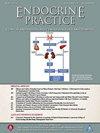Dental Implant Failure and Medication-Related Osteonecrosis of the Jaw Related to Dental Implants in Patients Taking Antiresorptive Therapy for Osteoporosis: A Systematic Review and Meta-Analysis
IF 4.6
3区 医学
Q2 ENDOCRINOLOGY & METABOLISM
引用次数: 0
Abstract
Objectives
To inform the 2024 International Task Force on Osteonecrosis of the Jaw update, we conducted a systematic review and meta-analysis evaluating dental implant failure and medication-related osteonecrosis of the jaw (MRONJ) related to antiresorptive therapy for osteoporosis.
Methods
We searched 5 databases (1946-2024) for interventional and noninterventional studies reporting rates of dental implant failure or osteonecrosis in those with osteoporosis or osteopenia. Two reviewers independently screened all titles, abstracts, and full texts. Risk of bias was assessed using the modified Ottawa-Newcastle scale, and the evidence was assessed using the Grading of Recommendations Assessment, Development, and Evaluation.
Results
We found 793 unique citations. Nine studies (n = 655) were included in the implant failure analysis. Random-effects meta-analysis revealed wide confidence intervals (CIs) for implant failure among those exposed to antiresorptives (relative risk, 0.82; 95% CI, 0.52-1.28; P = .38, very low certainty). Sensitivity analysis at the level of implant suggested that antiresorptives reduce implant failure (relative risk, 0.53; 95% CI, 0.34-0.81; P = .003, very low certainty). We identified 186 cases of MRONJ in implant recipients. The pooled rate of MRONJ following implantation in those exposed to antiresorptive therapy was 0.5% pooled from 21 cohorts. A single report of risk-adjusted MRONJ found that bisphosphonates increased MRONJ by 3 cases per 1000 patients (adjusted hazard ratio, 4.09; 95% CI, 2.75-6.09; P < .001, moderate certainty).
Conclusions
The low-certainty evidence suggests that antiresorptive therapy for osteoporosis reduces dental implant failure. Bisphosphonates are associated with MRONJ in patients with osteoporosis receiving dental implants with moderate certainty.
骨质疏松患者在接受抗吸收治疗时种植牙失败和药物相关性颌骨坏死(MRONJ):一项系统回顾和荟萃分析
目的:为了通知2024年国际颌骨坏死工作组更新,我们进行了一项系统回顾和荟萃分析,评估了与骨质疏松症抗吸收治疗相关的种植牙失败和药物相关的颌骨坏死(MRONJ)。方法:我们检索了5个数据库(1946-2024),以获取报告骨质疏松或骨质减少患者种植体失败或骨坏死发生率的介入性和非介入性研究。两位审稿人独立筛选了所有标题、摘要和全文。偏倚风险采用改进的渥太华-纽卡斯尔量表评估,证据采用GRADE评估。结果:共发现793条独特引用。9项研究(n=655)纳入了种植体失败分析。随机效应荟萃分析显示,使用抗吸收剂的患者种植体失败的置信区间很宽(RR 0.82, 95% CI 0.52 - 1.28, p = 0.38,非常低的确定性)。在种植体水平上的敏感性分析表明抗吸收剂可以减少种植体失败(RR 0.53, 95%可信区间0.34 - 0.81,p = 0.003,非常低的确定性)。我们鉴定了186例种植体受者的MRONJ。在21个队列中,接受抗吸收治疗的患者植入后MRONJ的总发生率为0.5%。一份风险调整后的MRONJ报告发现,双膦酸盐使MRONJ每1000例增加3例(调整后HR 4.09, 95% CI 2.75 - 6.09)。结论:低确定性证据表明,骨质疏松症的抗吸收治疗可能减少种植体失败。在接受植牙治疗的骨质疏松患者中,双膦酸盐与MRONJ有中度相关性。
本文章由计算机程序翻译,如有差异,请以英文原文为准。
求助全文
约1分钟内获得全文
求助全文
来源期刊

Endocrine Practice
ENDOCRINOLOGY & METABOLISM-
CiteScore
7.60
自引率
2.40%
发文量
546
审稿时长
41 days
期刊介绍:
Endocrine Practice (ISSN: 1530-891X), a peer-reviewed journal published twelve times a year, is the official journal of the American Association of Clinical Endocrinologists (AACE). The primary mission of Endocrine Practice is to enhance the health care of patients with endocrine diseases through continuing education of practicing endocrinologists.
 求助内容:
求助内容: 应助结果提醒方式:
应助结果提醒方式:


